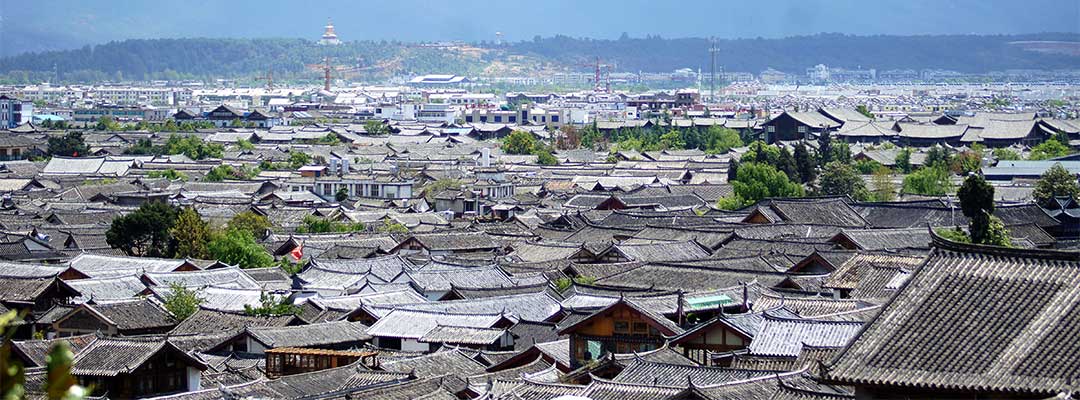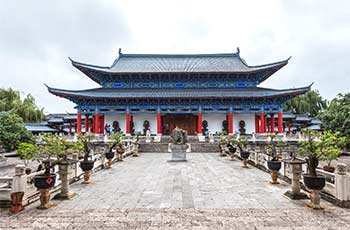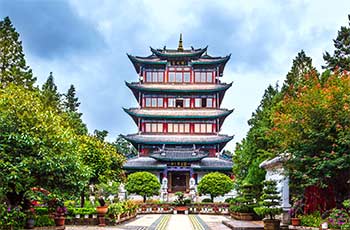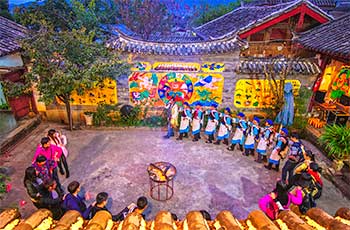Lijiang Old Town

Built in the late Song Dynasty and the early Yuan Dynasty (at the end of the 13th century), Lijiang Old Town, also known as Dayan Town, has a history of more than eight hundred years. It is one of the most famous towns along the Ancient Tea horse Road. It was inscribed into the World Cultural Heritage List on December 4th, 1997. With the beautiful scenery of a typical water town in the south of the Yangtze River, unique layout and architectural style, Lijiang Old Town is honored as “Suzhou on the highland”.
- Chinese name: 丽江古镇 Lì Jiāng Gǔ Chéng
- Duration: 1-2 days
- Entrance fee: RMB 80 for maintenance fee of Lijiang Old Town; the receipt is required when you visit Mufu Mansion and Black Dragon Pool Park.
- Opening hours: 24 hours
- Best time to visit: All year round. Lijiang has the plateau southwest monsoon climate and for the most part it is warm in winter and cool in summer with a small annual temperature difference. However, the temperature difference between day and night is relatively large. April is the best month to visit Lijiang Old Town when there are not quite as many visitors and the temperature is most comfortable. You can enjoy Rhododendron shrubs in the middle of May and Rhododendron trees in June. There are a large number of tourists during the peak season from July to October, among which, July and August are the rainy season of Lijiang. After October, the weather gets colder when the sun shines brightly and the temperature difference between day and night is large. Autumn and winter are the best time to watch migratory birds and enjoy the harvest scene outside the town. If you want to visit the Jade Dragon Snow Mountain at the same time, you do better to go there between December and January when it snows more and the scenery is more beautiful.
- Address: In the middle of Lijiang Dam, Lijiang, Yunnan Province.
- How to get there: You can change buses in Lijiang to get to Dayan Old Town. It is 28 kilometers from Lijiang Airport and can be reached by airport shuttle bus. It is 4.8 kilometers from Lijiang railway station. You can take a bus right outside of the railway station. Traveling along the highway is the most common route to get into Lijiang. There are 13 coach stations in the city. Most of them can be used as bus transfer stations to Lijiang Old Town. Taking a bus is also a convenient means of transport there. You can rent a bicycle if you want to visit the surrounding attractions of Lijiang Old Town.
Highlights of Lijiang Old Town
Sifang Street
 Sifang Street
Sifang Street Rectangle in shape, Sifang Street is located in the center of Lijiang Old Town. It is the hub of commerce and trade in the northwest Yunnan as well as the trade center in the Ancient Tea horse Road in the Ming and Qing Dynasties. Now it is the most popular landmark and the snack street in Lijiang Old Town. There are many special restaurants on both sides of the street, each serving special Yunan rice noodles. You can choose one to have a taste. Thus, Sifang Street is also called ”Lijiang Rice Noodles Street”. Xinhua Street besides Sifang Street is a famous bar street in Lijiang.
The Great Stone Bridge, 100 meters to the east of Sifang Street, is the representative of all bridges in Lijiang. It was built by Tusi, chief of Mu Clan in the Ming Dynasty. As Jade Dragon Snow Mountain is reflected on the river under the bridge, the Great Stone Bridge is also called Yingxue Bridge, which means the reflection of snow mountain. It is a stone arch bridge with two bridge openings. The bridge is over 10 meters in length and about 4 meters in width and the bridge deck was paved with traditional multi-colored slates.
 Mu Clan’s Mansion
Mu Clan’s Mansion Mu Clan’s Mansion
Mu Clan’s Mansion is the representative architecture in Lijiang Old Town. It was built in the Yuan Dynasty (A.D.1271-1368). Covering an area of about 30,682 square meters and having 162 rooms of different sizes, the mansion has eleven horizontal inscribed boards granted by emperors, which reflect the history of the Mu Clan. The famous TV series, the Vicissitude of Mu Clan was shot in the mansion. It was renamed as Ancient City Museum after reconstruction in 1998.
Five-Phoenix Tower
The 20-meter-high Five-Phoenix Tower was built in the 29th year of the Wanli period (A.D.1601) in the Ming Dynasty. As the building features five colorful flying phoenixes, it is named Five-Phoenix Tower. There are various delicate patterns on the ceiling of the tower. Five-Phoenix Tower combines various architectural styles, including that of Han, Tibetan and Naxi nationality and so on. It is the treasure and model of ancient Chinese architecture.
Wangu Pavilion
 Wangu Pavilion
Wangu Pavilion The mountain in the southeast corner of Lijiang Old Town, looking like a lion guarding the old town, is Lion Mountain. Up on the mountain you can find the best location to shoot a panoramic view of Lijiang Old Town. When the sky is clear after rain, you’ll have a chance to shoot the rainbow in the sky of the old city. In 1998, a park was built on the mountain. On top of the mountain there stands a five-star classical pavilion built solely with wood which is called “Wangu Pavilion”. The pavilion is 32.8 meters in height with sixteen 24-meter-high columns spiking to the top. There are 12,600 dragon head patterns of Naxi style in the tower, which makes the world record.
Lijiang Dongba Culture Museum
Located in the north of Black Dragon Lake, Lijiang Dongba Culture Museum was established in July, 1984. There are more than 10,000 valuable cultural relics and 52 of them are cultural relics at national level. There is a cultural relics museum, rarity museum, “Dongba culture” and ethnic customs photographs, and other exhibition halls open to the public in the museum.
Puji Temple
Puji Temple is located in Puji Mountain, 6 kilometers to the northwest of Lijiang Old Town. It was built in the 36th year of the Qianlong period (1771) in the Qing Dynasty. As one of the five Lama Temples in the Lijiang suburbs, it was famous for its copper tiles covering on the top of the hall. The yard of the temple is built in a quadrangle style. The temple was listed as a provincial protected historic site in 1988. In the yard of the temple there stand two Yunnan Cherry blossoms planted in 1771, which are considered the most beautiful cherry blossoms in Yunnan.
 Naxi Ancient Music Performance
Naxi Ancient Music Performance Naxi Ancient Music Performance
The Naxi Ancient Music Performance is displayed in the Dayan Ancient Music Association of East Street in Dayan Old Town. Many famous experienced artists participate in the performance which is hosted in both Chinese and English. The whole musical display is divided into two major modes, “Shenzhou” and “Huatong” and further divided into over fifty minor modes according to the contents. If you are interested in music and history, you can’t miss the Naxi Ancient Music Performance which is dubbed as the “Living Fossil of Naxi Music”. The ticket fee is RMB 150.
Drop us a line and we'll connect you with the top China expert in no time!